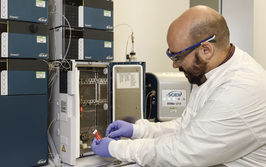Understanding the properties of dry powder inhaler formulations

contributed by Malvern Panalytical |
Abstract
Introducing a new approach for dry powder inhaler characterization aids understanding of the dispersion of the formulation during device actuation. In this note we show how the Morphologi automated imaging system can be used to understand the degree of powder dispersion achieved during the operation of a dry powder inhaler by analyzing powder fractions collected using cascade impaction.
Introduction
During research and development of orally inhaled and nasal drug products (OINDPs) Next Generation Impactors (NGIs) are well accepted and routinely used as a method to assess the aerodynamic particle size distribution of the drug in a formulation. This technique is described in both the European1 and United States Pharmacopeia2, which specify test methods for use with Dry Powder Inhalation (DPI) formulations. In general, it is accepted for DPI formulations that, to specifically target drug delivery to the lungs, the particles should be in the 1 to 5 micron size range. The aerodynamic size of particles expected to be collected at each stage of an NGI is calculated according to the flow rate of actuation as described in the Pharmacopeia.
An important advantage of the NGI as a particle sizer over other techniques is that, as well as classifying particles according to their aerodynamic particle size, it allows the chemical specificity of the particles to be determined via High Pressure Liquid Chromatography (HPLC). Thus, the fraction of active pharmaceutical ingredient (API) of the appropriate size to reach the target site can be assessed. However, the disadvantage of this method is that HPLC analysis requires the dissolution of collected particles, which means that all information about the physical properties of the particles at each stage is lost.
Log in or register to read this article in full and gain access to The Medicine Maker’s entire content archive. It’s FREE!



















